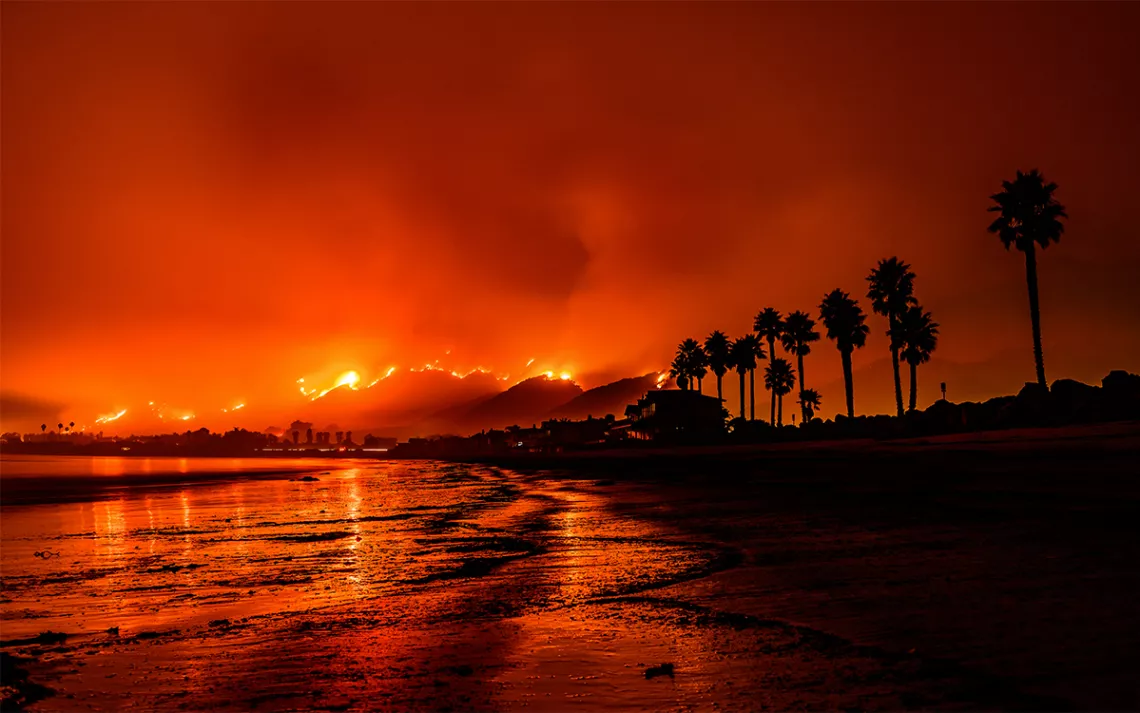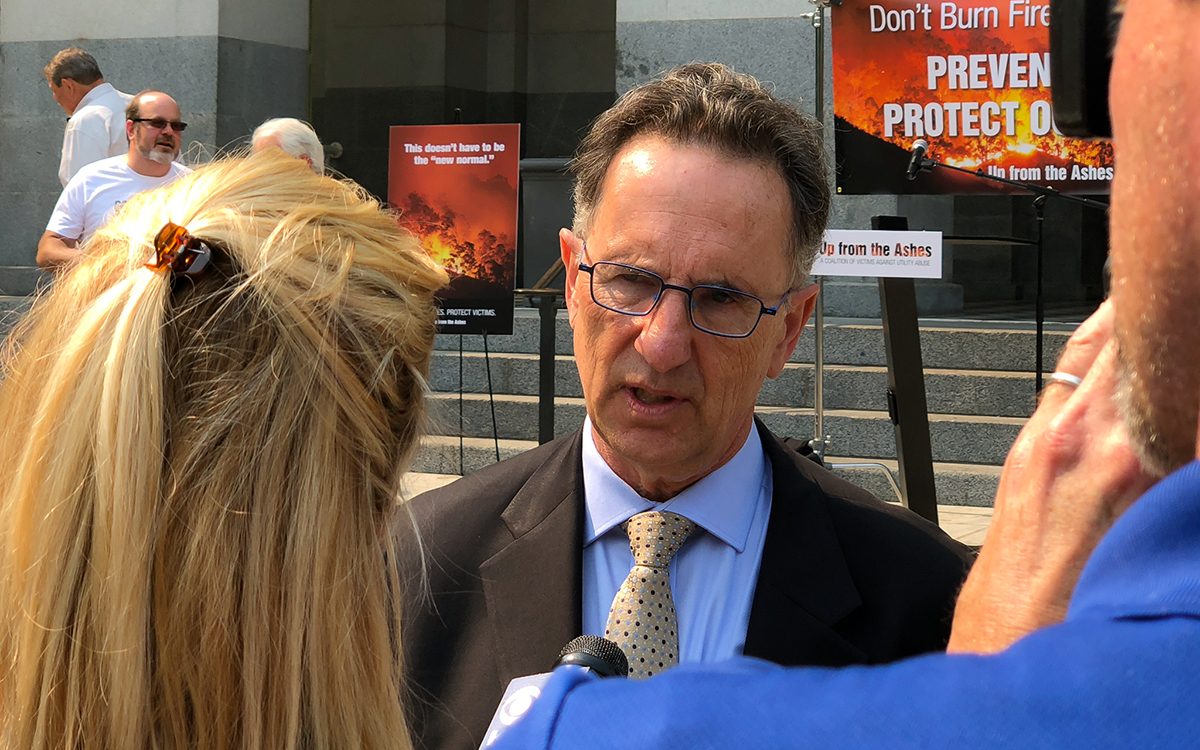Survivors Rise “Up From the Ashes”
Community activism group fights to hold PG&E accountable for wildfire damage

Photo by Carsten Schertzer/iStock
Patrick McCallum has told the story of what happened to him on October 8, 2017, dozens of times. The emotions, he says, are less raw now; he doesn’t feel as vulnerable relaying the events of the night he almost lost his life.
But as he talks while driving down the highway, pausing occasionally to make sure he doesn’t miss his exit, the pain that he and his wife experienced still carries. So, too, does McCallum’s conviction to seek justice against Pacific Gas and Electric, the power company that he believes is responsible for the trauma and loss he, and so many others, suffered.
Today, McCallum is an organizer with Up From the Ashes, a community activism group that helps to advocate for people in Sonoma and Napa and throughout California who lost their homes to wildfires. The group was formed in the aftermath of one of the most horrific fires in California history—a firestorm that killed 44 and displaced thousands—outpaced only by the Camp Fires of this fall.
When McCallum’s house went up in flames, he was asleep, he said, and woke up to the sound of alarms going off around 4 A.M. He resisted getting out of bed—after all, it was the middle of the night. His wife, Judy, slipped on a robe to investigate. The events that followed have haunted them both ever since. Their house in Fountaingrove, a neighborhood of Santa Rosa, “melted,” said McCallum—a house they had bought so that Judy, the president of Sonoma State University, could entertain visitors.
“It was such a beautiful house. I loved that backyard. Those trees. I was so connected to those trees,” said McCallum.
They barely escaped with their lives.
“There were flames everywhere, like Dante’s inferno, we always say. There were sparks on the driveway as we ran. Our feet burned,” McCallum said. The pair, running from the flaming house in their pajamas, didn’t even have time to put on shoes. They ran uphill toward the road—a distance of an eighth of a mile through thick smoke that McCallum says was one of the hardest things he has ever done—and were eventually picked up by off-duty firemen who had been driving through to look for survivors who needed help.
The couple have since bought a new house, but they have not put the fire behind them. “We have spent the last 13 months trying to rebuild our lives,” said McCallum.
Up From the Ashes now has a thousand members, and they have one thing in common: They are wildfire victims and they hold PG&E responsible for the disasters that they survived.

Photo courtesy of Patrick McCallum
While the causes of all the wildfires last year have not been determined, including the cause of the Tubbs Fire (the largest of 2017), Cal Fire did determine that PG&E had a role in 11 of the smaller fires. Of the 12 investigations the agency completed by June, there was only one not linked to PG&E, the Nun Fire, and even that was caused by a power line—the report Cal Fire released just didn’t state to whom the line belonged.
Ever since PG&E caused a major pipeline explosion in San Bruno, California, in 2010, faith in the utility has been waning, but wildfires have put a new spotlight on the company. While climate change undeniably plays a role in wildfires, McCallum says, PG&E is still responsible for its negligence. “You can’t blame climate change for these fires,” he said. “Climate change made them substantially worse, but for the most part, these fires were caused by IOUs. . . . We need to keep working on making our electrical grid safer and assessing how it should be run.”
In September, Governor Brown signed SB 901, a bill referred to by critics as a “bailout” of PG&E that allows the company to use bonds to pay off its liabilities. Up From the Ashes actually supported the bill, because the cost to customers for PG&E to pay off liabilities could be so extreme.
“We thought it was the best balance that could be struck at the time. It has a lot of fire mitigation components, and it protects liability, and we insisted on a stress test to be sure that every dollar available be taken out of PG&E,” explained McCallum. The bill protected the utility from bankruptcy, which would likely negatively impact victims themselves.
The group is also pressing for an audit of the energy company.
Meanwhile, speculation continues about whether PG&E was responsible, either fully or partially, for the Camp Fire. PG&E has reported that on the morning of November 8, the day that the Camp Fire began, it experienced two outages in Butte County, one near the unincorporated region of Concow and another near the town of Pulga. The Camp Fire is the deadliest in state history; the death toll currently sits at 86. It destroyed most of the town of Paradise, California, burning down more than 13,000 homes. McCallum has spoken to eight Camp Fire victims since the fire began; eventually, he hopes, many of the victims of the fire will join the organization.
In response to a request for comment on the outages, PG&E replied, “There will be a time and place for discussing this and other matters. Right now, we are focused on assessing infrastructure, safely restoring power where possible, and helping our customers recover and rebuild.”
The company did launch a Community Wildfire Safety Program to help deal with the reality of wildfires in California and to increase fire defense zones (buffers between vegetation and power lines). But the website for the program describes wildfires caused by “extreme weather events,” not negligence on the part of the company.
 The Magazine of The Sierra Club
The Magazine of The Sierra Club



